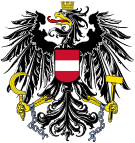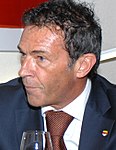| |||||||||||||||||||||||||||||||||||||||||||||||||||||||||||||||||
183 seats in the National Council of Austria 92 seats needed for a majority | |||||||||||||||||||||||||||||||||||||||||||||||||||||||||||||||||
|---|---|---|---|---|---|---|---|---|---|---|---|---|---|---|---|---|---|---|---|---|---|---|---|---|---|---|---|---|---|---|---|---|---|---|---|---|---|---|---|---|---|---|---|---|---|---|---|---|---|---|---|---|---|---|---|---|---|---|---|---|---|---|---|---|---|
| |||||||||||||||||||||||||||||||||||||||||||||||||||||||||||||||||
 Results of the election, showing seats won by state and nationwide. States are shaded according to the first-place party. | |||||||||||||||||||||||||||||||||||||||||||||||||||||||||||||||||
| |||||||||||||||||||||||||||||||||||||||||||||||||||||||||||||||||
| This article is part of a series on the |
| Politics of Austria |
|---|
 |
Early parliamentary elections were held in Austria on 23 November 1986.[1] They were called by Chancellor Franz Vranitzky of the Socialist Party (SPÖ), as he was not prepared to continue the coalition government with new Freedom Party (FPÖ) leader Jörg Haider, who had ousted Norbert Steger at the party convention.
The SPÖ won the most seats, and formed a grand coalition with the Austrian People's Party (ÖVP), as neither were willing to work with Haider. The Green Alternative won eight seats, marking the first time a party other than the SPÖ, ÖVP and FPÖ had entered parliament since 1959 election. Voter turnout was 90%.[2]
- ^ Dieter Nohlen & Philip Stöver (2010) Elections in Europe: A data handbook, p196 ISBN 978-3-8329-5609-7
- ^ Nohlen & Stöver, p216





